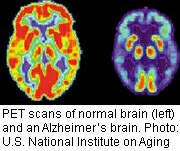Study finds widespread changes using specialized MRI
WEDNESDAY, May 27, 2015 (HealthDay News) — Damage to the brain’s white matter may be an early sign of certain types of Alzheimer’s disease, according to a study published online May 27 in Radiology.
Researchers used diffusion tensor magnetic resonance imaging to assess white matter in 53 people with three different types of Alzheimer’s: early-onset Alzheimer’s disease, logopenic variant of primary progressive aphasia, and posterior cortical atrophy.
All of the patients had extensive white matter damage, along with regional gray matter damage. “Alzheimer’s is a gray matter disease. However, white matter damage has a central role in how the disease strikes and progresses,” study coauthor Federica Agosta, M.D., Ph.D., from the Neuroimaging Research Unit at the San Raffaele Scientific Institute in Milan, said in a news release from the Radiological Society of North America. “The white matter damage in patients with focal Alzheimer’s disease syndromes was much more severe and widespread than expected,” she said. Changes in gray matter occurred in more limited areas, she added.
The findings support the theory that Alzheimer’s disease may travel along white matter fibers from one area of the brain to another, according to Agosta. “In early onset Alzheimer’s disease and atypical Alzheimer’s disease forms, white matter degeneration may be an early marker that precedes gray matter atrophy,” she said. That means that this specialized imaging technique might be able to identify people even before symptoms of Alzheimer’s are apparent.
Full Text (subscription or payment may be required)
Copyright © 2015 HealthDay. All rights reserved.








